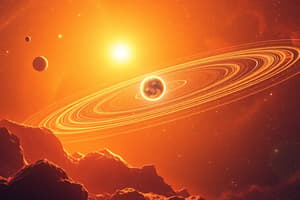Podcast
Questions and Answers
What is the significance of Hubble's Law?
What is the significance of Hubble's Law?
- It proves that the Big Bang didn't happen.
- It describes the formation of black holes.
- It states that light travels in a vacuum.
- It suggests that the universe is expanding. (correct)
What does a light year measure?
What does a light year measure?
- The total energy of light emitted in a year.
- The distance light travels in one year. (correct)
- Time taken by light to travel.
- The speed of light over a year.
What is the approximate speed of light?
What is the approximate speed of light?
- 300,000 kilometers per hour.
- 300,000 miles per hour.
- 186,000 miles per second. (correct)
- 186,000 miles per hour.
What major event is associated with the origin of the universe?
What major event is associated with the origin of the universe?
What does the Cosmic Microwave Background radiation represent?
What does the Cosmic Microwave Background radiation represent?
Which elements are considered 'light elements' supporting the Big Bang theory?
Which elements are considered 'light elements' supporting the Big Bang theory?
What does the Big Bang theory suggest about the early universe?
What does the Big Bang theory suggest about the early universe?
How does the speed of light in miles per second translate to distance in one year?
How does the speed of light in miles per second translate to distance in one year?
What is the main process described in the Solar Nebula theory?
What is the main process described in the Solar Nebula theory?
Which of the following describes the initial phase of star and planet formation?
Which of the following describes the initial phase of star and planet formation?
What event expels the nebular gas during the formation process?
What event expels the nebular gas during the formation process?
What happens to dust grains during the planet formation process?
What happens to dust grains during the planet formation process?
How long ago did the Sun and our solar system form?
How long ago did the Sun and our solar system form?
What is a key characteristic of planetesimals in the formation process?
What is a key characteristic of planetesimals in the formation process?
Flashcards are hidden until you start studying
Study Notes
Light Year
- Light year is a unit of distance measurement, not time.
- Light travels at approximately 186,000 miles per second (300,000 kilometers per second).
- One light year equals the distance light travels in one year: about 5.87 trillion miles (approximately 9.46 trillion kilometers).
Big Bang Theory
- The universe originated from a hot explosion known as the Big Bang.
- Post-Big Bang conditions were primarily radiation; as the universe cooled, hydrogen and helium formed.
- Evidence supports the Big Bang theory:
- The universe is believed to have had a definitive beginning.
- Hubble's Law indicates that galaxies are moving away, suggesting universal expansion from a compact state.
- In 1965, Cosmic Microwave Background radiation (CMB) was discovered, measuring about 2.725 K, indicating remnants of heat from the Big Bang.
- The observed abundance of hydrogen and helium aligns with predictions of the Big Bang model.
Planet Formation
- Planets and stars form from the same primordial gas and dust cloud.
- Observations of T Tauri stars show planet formation in dust disks around them.
- The solar nebula, a spinning disk, was where the solar system (including the Sun) formed approximately 5 billion years ago.
- The formation process involves:
- The solar nebula contracting and flattening.
- The central mass becoming the Sun and smaller masses potentially forming jovian planets.
- Dust grains acting as condensation nuclei, leading to moon-sized planetesimals.
- The expulsion of gaseous nebula by strong solar winds.
- Continued collisions among planetesimals forming larger planets with circular orbits.
Relationship between Theories
- The Big Bang theory discusses the creation of matter and energy in the universe.
- The Solar Nebula theory addresses how that matter evolves into galaxies and solar systems.
Studying That Suits You
Use AI to generate personalized quizzes and flashcards to suit your learning preferences.




